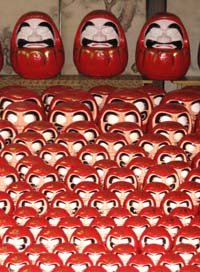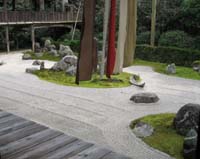RYOTANJI
 We took the expressway, the faster to escape the mind-numbing clutches of the shadowy fingers that reached out for me as I raced away: "If 'Yes,' attach a copy of schedule C (or F) and SE and Form 2555 of your United States Income Tax Return filed for each year [!!!] of the work period shown in item 1."
We took the expressway, the faster to escape the mind-numbing clutches of the shadowy fingers that reached out for me as I raced away: "If 'Yes,' attach a copy of schedule C (or F) and SE and Form 2555 of your United States Income Tax Return filed for each year [!!!] of the work period shown in item 1."Already my mind was clearing as I anticipated the calming and nurturing environs I would find in the small, temple-rich town of Hikone across the Lake. One of those temples is Ryotanji. I had ever been to that particular temple, though I've spent a lot of time in the town of the famed castle.
We were going to Ryotanji because we'd read an announcement about the Daruma festival that was going on there, which sounded interesting. I wasn't expecting much more than the general peaceful bustle and non-right-in-your-face spiritual ambience of the average temple festival, which qualities are always welcome in modern life - maybe with some unique cultural/aesthetic/historical aspects thrown in as mindgravy - but as it turned out, Ryotanji was a sleeper; it knocked my socks off.

Tucked away among the hills at the edge of Hikone, Ryotanji was originally built in 734; it later became the family temple of the Ii clan, (who were given what is now Shiga Prefecture when they wound up on the winning (Tokugawa) side in the Battle of Sekigahara, which led to a unified Japan). Ryotanji carries that historic, spiritual and aesthetic tradition in every surface of its ancient presence.
From the brief brochure: "The teachings [at Ryotanji, Zenrenzai sect] specialize in the subject of landscape gardening, and many students who have studied here have gone on to be so called 'Gardening Priests,' establishing gardens in many temples throughout Japan." And what gardens; if you're in the vicinity, go there.
Now that's social security.


















4 comments:
What a beautiful setting Robert...restful and serene. I can see where you could just sit there all day and take it in.
Yes, it was easy...
And so you post this on the Internet? Are you crazy? Can you imagine what it will be like next year?
Those folks will be the best kind of crowd.
Post a Comment